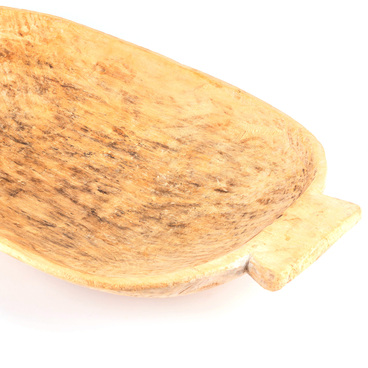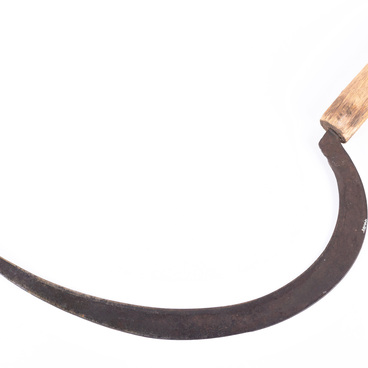A yarnwindle is a device that was used on a wide scale to produce yarn. The museum showcases a yarn winder that was made in 1910. It is a wooden rod used to wind yarn from the spindle into skeins. One end of the yarnwindle had a crossbar, and its length could reach up to 70 centimeters. At the other end, there is a board nailed perpendicularly. When unwinding the yarn from the spindle, it was tied to the reel at the end, and the spindle was either left in its basket or on the floor, or its sharp end was rested against the spinning wheel, with the blunt end held up to the person’s stomach. Consequently, when the yarnwindle rotated, the yarn was rewound from the spindle into skeins.
The production of yarn is traditionally considered the most labor-intensive process in weaving. To obtain high-quality yarn, it was necessary first to prepare the raw materials for spinning, which were most often wool, flax, or hemp. After cleaning and drying the flax or hemp, it needed to be threshed, meaning compressed and flattened to the greatest possible extent. Then the flax or hemp was soaked, and after drying it was then crushed, ruffled, and scratched. To give the fibers the maximum degree of softness and flexibility, they were also sometimes ground in a mortar. Preparing wool for spinning took much less time than processing flax and hemp: after shearing the sheep, the wool was washed, taken apart by hand, and dressed with a comb. After finishing the process of preparing the raw material, the very long and complicated spinning process began.
The method of making yarn itself — spinning — was invented a long time ago. Initially, the yarn was twisted by hand, but later the spindle was invented, and then the hand spinning wheel appeared. It is commonly known that spinning wheels were used in India more than 2,500 years ago. By the 15th century, improved versions of spinning wheels, treadle spinning wheels, had spread throughout Europe, which greatly simplified the production of yarn. Up to the end of the nineteenth and the beginning of the twentieth century, hand spinning wheels were in almost every Russian peasant family. They disappeared from pervasive use in everyday life only after industry became well-developed, when factory-made yarns and fabrics became easier, and cheaper, to buy than to make by hand.
The production of yarn is traditionally considered the most labor-intensive process in weaving. To obtain high-quality yarn, it was necessary first to prepare the raw materials for spinning, which were most often wool, flax, or hemp. After cleaning and drying the flax or hemp, it needed to be threshed, meaning compressed and flattened to the greatest possible extent. Then the flax or hemp was soaked, and after drying it was then crushed, ruffled, and scratched. To give the fibers the maximum degree of softness and flexibility, they were also sometimes ground in a mortar. Preparing wool for spinning took much less time than processing flax and hemp: after shearing the sheep, the wool was washed, taken apart by hand, and dressed with a comb. After finishing the process of preparing the raw material, the very long and complicated spinning process began.
The method of making yarn itself — spinning — was invented a long time ago. Initially, the yarn was twisted by hand, but later the spindle was invented, and then the hand spinning wheel appeared. It is commonly known that spinning wheels were used in India more than 2,500 years ago. By the 15th century, improved versions of spinning wheels, treadle spinning wheels, had spread throughout Europe, which greatly simplified the production of yarn. Up to the end of the nineteenth and the beginning of the twentieth century, hand spinning wheels were in almost every Russian peasant family. They disappeared from pervasive use in everyday life only after industry became well-developed, when factory-made yarns and fabrics became easier, and cheaper, to buy than to make by hand.



